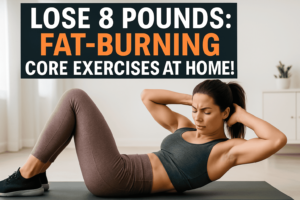If you’re looking to lose weight and sculpt your body, resistance training should be a key component of your fitness routine. Resistance training exercises engage multiple muscle groups and promote fat loss, making it an effective method for achieving weight loss goals. In this article, we’ll explore 7 highly effective methods for weight loss through resistance training, so you can achieve the physique you desire.
Key Takeaways:
- Resistance training exercises can help you burn fat and build muscle
- Compound exercises engage multiple muscle groups for maximum fat burn
- High-Intensity Interval Training (HIIT) can accelerate weight loss
- Progressive overload promotes muscle growth and fat loss
- Targeted strength training can help you tone and shape specific problem areas
I. Understanding the Benefits of Resistance Training
Resistance training, also known as strength training or weightlifting, involves any exercise that causes your muscles to contract against an external resistance, such as weights, resistance bands, or your own body weight. While resistance training is a popular method for building muscle mass and strength, it also offers numerous benefits for weight loss and overall health.
(Discover essential workouts accessories for women on sale—enhance your workout routine today!)
One of the primary benefits of resistance training for weight loss is that it helps to increase muscle mass while also reducing body fat. Unlike cardio exercises, which primarily burn calories while you perform them, resistance training boosts your metabolism, allowing you to burn calories and fat long after your workout is over. Additionally, resistance training can help prevent the loss of muscle mass that often occurs with weight loss, allowing you to maintain a strong and toned physique.
Resistance training also offers a range of other health benefits, including improved bone density, better joint health, and increased strength and stamina. Studies have shown that regular resistance training can help to reduce the risk of chronic conditions such as heart disease, diabetes, and mental health conditions like anxiety and depression.
Overall, resistance training is an excellent way to achieve your weight loss goals and improve your overall health and well-being. By incorporating resistance training into your fitness routine, you can reap the many benefits it has to offer and transform your body and mind for the better.

II. Compound Exercises for Maximum Fat Burn
If your goal is to burn fat and lose weight through resistance training, you should focus on compound exercises. These exercises involve multiple muscle groups and help burn more calories than isolation exercises. The best resistance training for weight loss includes compound exercises like squats, lunges, deadlifts, bench presses, and pull-ups.

Squats
Squats stand as a cornerstone compound exercise renowned for their ability to target multiple muscle groups simultaneously, including the quadriceps, hamstrings, glutes, and core. This versatile movement not only builds strength but also enhances overall lower body muscle tone. Whether performed with just body weight or incorporating additional resistance through barbells or dumbbells, squats prove to be an effective exercise for developing functional strength and promoting lower body flexibility.
How to Do:
Starting Position: Stand with feet shoulder-width apart, maintaining a straight posture, and keeping the weight centered on your heels.
Descend into Squat: Lower your body by bending at the knees and hips, pushing your buttocks back as if sitting into an imaginary chair. Ensure your knees do not extend beyond your toes.
Maintain Neutral Spine: Keep your back straight, chest up, and shoulders back throughout the movement. Engage your core to stabilize your torso.
Depth of Squat: Descend until your thighs are parallel to the ground, or as far as comfortably possible while maintaining good form.
Push Through Heels: Push through your heels to ascend back to the starting position, fully extending your hips and knees.
Breathing: Inhale as you lower into the squat, and exhale as you rise back up.
Variations: Experiment with different squat variations, such as front squats, goblet squats, or sumo squats, to target muscles from varied angles.
Repetition and Sets: Aim for 3 sets of 8-12 repetitions, adjusting intensity based on your fitness level and goals.
Lunges
Lunges are another powerful lower body exercise that engages the glutes, hamstrings, quads, and calves. They can be performed in various ways, such as forward lunges, reverse lunges, or walking lunges. Adding dumbbells or kettlebells can further challenge the muscles and promote strength development.

How to Do:
Starting Position: Stand upright with feet hip-width apart.
Step Forward or Backward: Take a step forward or backward with one foot, lowering the body until both knees form 90-degree angles.
Maintain Proper Alignment: Ensure the front knee is directly above the ankle, and the back knee hovers slightly above the ground. Keep the torso straight and avoid leaning too far forward.
Push Back to Starting Position: Use the front foot to push back to the starting position, bringing both feet together.
Repeat on Both Legs: Perform the lunges on both legs, alternating between them.
Add Resistance for Intensity: To intensify the workout, hold dumbbells or kettlebells in each hand while performing lunges.
Sets and Repetitions: Aim for 3 sets of 10-15 repetitions per leg, adjusting the intensity based on your fitness level.
Deadlifts
Deadlifts are a compound exercise that targets the posterior chain, including the glutes, hamstrings, lower back, and core. Proper form and technique are crucial to prevent injuries. Starting with lighter weights and gradually increasing the load can help develop overall strength and improve posture.

How to Do:
Starting Position: Stand with feet hip-width apart, toes pointing forward. Place a barbell in front of you, aligning it with the mid-foot.
Grip the Barbell: Bend at the hips and knees to lower your body, grasping the barbell with either an overhand grip (both palms facing you) or a mixed grip (one palm facing you, one facing away).
Set Your Back: Ensure your back is straight, chest lifted, and shoulders pulled back. Engage your core to maintain stability.
Lift the Barbell: Push through your heels, extend your hips and knees simultaneously, lifting the barbell as you stand upright. Keep the barbell close to your body.
Full Extension: Stand tall with your hips and knees fully extended, shoulders back, and chest lifted at the top of the movement.
Lower the Barbell: Hinge at the hips and bend your knees to lower the barbell back to the ground, maintaining control and proper form.
Repetition and Progression: Start with a moderate weight and aim for 3 sets of 8-12 repetitions. Gradually increase the weight as your strength improves.
Bench Press
A staple of strength training, the bench press is a well-known upper body complex exercise that focuses mostly on the chest, shoulders, and triceps. It makes a significant contribution to the development of upper body strength and muscles. To progressively build strength, beginners might begin with smaller weights or even utilize resistance bands. Maintaining a steady grasp and using the core are two aspects of proper form that are necessary for best outcomes.

How to Do:
Starting Position: Lie on a flat bench with your feet flat on the ground. Position the barbell over your chest, hands slightly wider than shoulder-width apart.
Grip the Barbell: Grasp the bar with an overhand grip, keeping your wrists straight. Ensure a secure grip on the barbell.
Lower the Barbell: Lower the barbell to your chest by bending your elbows. The bar should touch your chest lightly, and your elbows should form a 90-degree angle.
Push the Barbell Up: Push the barbell back up to the starting position, fully extending your arms. Keep your back, head, and buttocks firmly on the bench.
Controlled Movement: Perform the exercise in a controlled manner, avoiding rapid movements or bouncing the barbell off the chest.
Engage the Core: Keep your core engaged throughout the movement to provide stability and protect your lower back.
Breathing: Inhale as you lower the barbell and exhale as you push it back up.
Repetition and Progression: Aim for 3 sets of 10-15 repetitions, adjusting based on individual fitness levels. Gradually increase the weight as your strength improves.
Compound exercises are also great for building strength and improving overall fitness. They challenge your balance and coordination and help you develop functional movements that improve daily activities.
When performing compound exercises, it’s important to maintain proper form and technique to avoid injuries. Start with lighter weights and gradually increase the intensity as your body adapts. Aim to perform these exercises two to three times per week for maximum fat burn and weight loss results.

III. High-Intensity Interval Training (HIIT)
Resistance training alone is excellent for sculpting muscles, but combining it with high-intensity interval training takes it to a new level.
HIIT involves alternating periods of intense activity with short rest periods. This way, you can push your body to work hard, resulting in an increased heart rate and boosted metabolism even hours after your workout is complete. HIIT also increases endurance and strengthens your cardiovascular system.

Research has shown that HIIT is remarkably effective for weight loss and burning fat. When combined with resistance training, it creates an ideal environment for achieving your weight loss goals while toning your muscles.
There are many ways to incorporate HIIT into your resistance training routine. For example, you can add a 30-second sprint on a treadmill after each set of weightlifting exercises. Or you can perform a series of bodyweight exercises, such as burpees or jumping jacks, followed by a short rest period. The possibilities are endless.
Related: Empowering Home Workouts: 22 No-Equipment HIIT Routines for Women of Every Fitness Level
If you are new to HIIT, start with shorter intervals and longer rest periods, gradually increasing the intensity as your fitness level improves. Remember, HIIT is challenging but highly rewarding.
Try incorporating HIIT into your resistance training routine to accelerate weight loss, improve cardiovascular fitness, and achieve optimal results.
IV. Progressive Overload for Muscle Growth
Resistance training for weight loss results requires a thoughtful approach. One principle that can help you achieve your goals is progressive overload.
Progressive overload involves gradually increasing the intensity and challenge of your workouts to promote muscle growth and fat loss. By challenging your muscles beyond their current capacity, your body is forced to adapt and grow stronger, which can lead to significant weight loss and a more sculpted physique.
There are various ways to implement progressive overload in resistance training. You can gradually increase the weight you lift, add more sets or reps to your exercises, or try more challenging variations of the same exercises. Consistent application of progressive overload can ensure continued progress towards your weight loss and fitness goals.
The benefits of progressive overload go beyond weight loss. As your muscles grow stronger, you may also enjoy improved overall strength and performance in other areas of your life.
Incorporating progressive overload into your resistance training routine is a proven way to stimulate weight loss and muscle growth. Try incorporating this principle into your workouts and experience the benefits of resistance training for yourself.
V. Targeted Strength Training for Problem Areas
Resistance training exercises can be customized to target specific problem areas. For example, if you want to tone and firm your arms, you can try bicep curls, tricep extensions, and push-ups. Lunges, squats, and leg presses are great for toning and shaping the thighs.
Abdominal muscles can be targeted with a variety of exercises, including crunches, planks, and Russian twists. By incorporating these targeted strength training exercises into your resistance training routine, you can achieve optimal fat loss and muscle tone in your problem areas.

Remember, spot reduction of fat is not possible, but resistance training can help you build muscle and reduce overall body fat percentage, leading to a more toned and sculpted appearance.
VI. Nutrition Tips for Weight Loss
While resistance training is an excellent way to burn fat and build muscle, it’s equally essential to pay attention to your nutrition to achieve effective weight loss. Consider the following tips that can complement your resistance training efforts and optimize your weight loss journey:
Eat a balanced diet:
Include plenty of fruits and vegetables, lean proteins, whole grains, and healthy fats in your diet to fuel your workouts and promote weight loss.

- Stay hydrated:
Drinking plenty of water throughout the day can help you curb hunger, boost metabolism, and flush out toxins from your body.

- Limit processed foods:
Processed foods are typically high in sugar, fat, and calories, which can impede your weight loss progress. Limiting your intake of processed foods can help you stay on track with your weight loss goals. - Avoid fad diets:
While fad diets might promise quick weight loss results, they often lack essential nutrients and can be unsustainable in the long term. Instead, focus on making gradual lifestyle changes that you can maintain over time.
By incorporating these simple and effective nutrition tips into your routine, you can support your resistance training efforts and optimize your weight loss journey. Remember to consult with a healthcare professional before making significant changes to your diet or exercise routine.
VII. Incorporating Resistance Training into Your Routine
If you want to achieve weight loss and muscle-building goals, incorporating resistance training into your daily routine is crucial. Fortunately, it’s easy to fit a resistance training workout into your schedule regardless of whether you prefer working out at the gym or in the comfort of your own home.
Start with simple resistance training exercises like push-ups, squats, or lunges and gradually increase the intensity and duration of your workouts. You can also use resistance bands or free weights (dumbbells) to challenge yourself further.
When training at the gym, consider using weight machines or taking part in group fitness classes that incorporate resistance training exercises. Professionals at the gym can help you learn proper form, ensure your safety, and help you set and achieve realistic goals.
Resistance training exercises can be adapted to any fitness level and performed anytime, anywhere, with no special equipment needed. So why not start right now and boost your weight loss results?
VIII. Staying Motivated and Overcoming Plateaus
Resistance training can be a challenging but rewarding journey toward weight loss and a sculpted physique. However, it is crucial to stay motivated and overcome the inevitable plateaus that may arise.
A great way to boost motivation is to set achievable goals for yourself and track your progress regularly. Whether it’s a certain number of reps or lifting a heavier weight, celebrate your successes and keep pushing yourself to improve.
Another effective strategy is to mix up your routine and try new exercises to keep things fresh and exciting. This can help prevent boredom and make your workouts more enjoyable.
If you do hit a plateau, don’t give up. Instead, reassess your routine and make any necessary changes, such as increasing intensity or incorporating different exercises. Remember that progress takes time, and positive results will come with commitment and consistency.
Overall, staying motivated and overcoming plateaus are key to achieving weight loss through resistance training. Keep pushing yourself, exploring new exercises, and tracking your progress, and you will see the results you desire.
Conclusion
Resistance training is an excellent way to achieve your weight loss goals while building muscle and improving your overall health. By understanding the numerous benefits of resistance training and incorporating the seven effective methods we’ve explored, achieving a toned and sculpted physique is within reach.
Remember, effective weight loss is not just about exercise; proper nutrition is a crucial component too. Be sure to follow the nutrition tips we’ve outlined to complement your resistance training efforts and optimize your weight loss results.
Whether you prefer working out at the gym or in the comfort of your own home, with the guidelines and exercises provided, you can easily incorporate resistance training into your routine regardless of fitness level.
It’s important to stay motivated and track your progress along the way. Use the strategies we’ve discussed to maintain your motivation and break through any weight loss plateaus.



